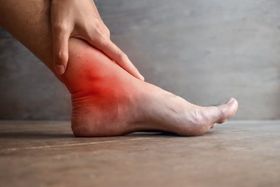Tailor’s Bunion: Causes, Symptoms, and Treatment
Updated February 10, 2023

A tailor's bunion, also called a bunionette, is a growth on the outside of the foot at the base of the last 5th metatarsal bone (pinky toe). A tailor's bunion looks like a swollen, hard bump on the outer portion of the little toe.
Symptoms of Tailor’s Bunion
- A tailor's bunion feels like a painful, red area with swelling at the site of the enlargement.
- The presence of callous or corn (smaller type of callous) on or near the bunion due to the effect of friction on the skin.
- Possibility of infection due to the presence of broken skin around the bony lump.
Causes of Tailor’s Bunion
There are several causes for the formation of a bunion on the side of the pinky toe:
- Tight shoes that constrict the feet.
- Weight gain.
- Structural problems with the feet.
- Wearing high heels that put strain on the feet.
- Poor foot function.
- Large head of the 5th metatarsal bone.
- Abnormally shaped little toes.
- Loose ligaments.
- Supinated foot.
Can You Correct Tailor’s Bunion Without Surgery?
There are several ways to get rid of bunions on the pinky toe without surgery. The best way to slow the progression of a tailor's bunion and help it shrink naturally is by following a conservative treatment during the early stages.
A few steps you can follow at home are:
- Maintaining a healthy body weight.
- Wearing proper-fitting shoes that are wider near the toes.
- Using shoe inserts to help position the foot correctly.
- Using ice packs, warm socks, and massage.
- Using custom-made orthotics for bunions.
- Using bunionette pads and cushions.
- Wearing bunion splints (also known as bunionette toe spacers) at night may help alleviate pain.
Exercises for Tailor's Bunion
Exercises for bunionette pain are effective as a preventive and curative measure. They help in keeping the feet healthy and hopefully free from surgery by improving blood circulation, movement, and flexibility of the muscles and joints of the foot and toes.
All the below exercises can be carried out as a home treatment for bunionettes:
- Toe spread outs
- Toes circles
- Marble pickup
- Heel raises
- Ankle toe pumps
- Barefoot beach walking
- Self-massage
- Towel grip and pull exercise
- Ice massage with a frozen bottle
- Toe squeezes
» Ease bunion pain with the best exercises for tailor’s bunion
How Do You Keep Your Bunionettes From Getting Worse?
The best way to keep your tailor's bunion from getting worse is by wearing proper shoes with a wide toe box. Additionally, exercising the feet and your toes three times every day will play a key role in preventing the bunionettes from worsening and avoiding the need for surgery.
Following your healthcare practitioner's advice, the do’s and don’ts, maintaining a healthy weight, and wearing a custom orthotic inside a well-fitted shoe will assure that your bunionettes don't get worse.
» Interested in custom orthotics? Browse our online store and get yourself a pair.
Is Tailor’s Bunion Surgery Worth It?
Sometimes, in the case of a chronic tailor's bunion that is causing excessive pain, surgery is the only option. Though you are still able to receive surgery in less severe cases, you'll have to weigh up the pros and cons to decide if it's going to be worth it.
Bunionette surgery itself is not painful since the patient is under the effect of general anaesthetic. However, it may take about 4-6 months to recover from tailor's bunion surgery.
Depending upon the nature of your job (whether sedentary or physical), the surgeon will make recommendations as to when you are allowed back on your feet. Generally speaking, walking can be started 0-6 weeks post-op in a hospital shoe with full weight-bearing on your legs. Post six weeks you may be able to fully bear weight on your affected foot and walk in your regular shoes.
Additionally, another factor to weigh up when deciding if surgery is worth it is cost. Not everyone has insurance that will cover this type of procedure, and so the best way to find out is by getting in contact with your insurance company and hospital.
When Does a Tailor’s Bunion Need Surgery?
Needing surgery for tailor's bunion is multifactorial.
If there is the presence of symptoms such as severe foot pain, swelling, and redness with no reduction in them after implementing conservative treatment options, then you may need surgical excision of the bunion. Consult a podiatrist or GP if you are unsure of the severity of your situation.








